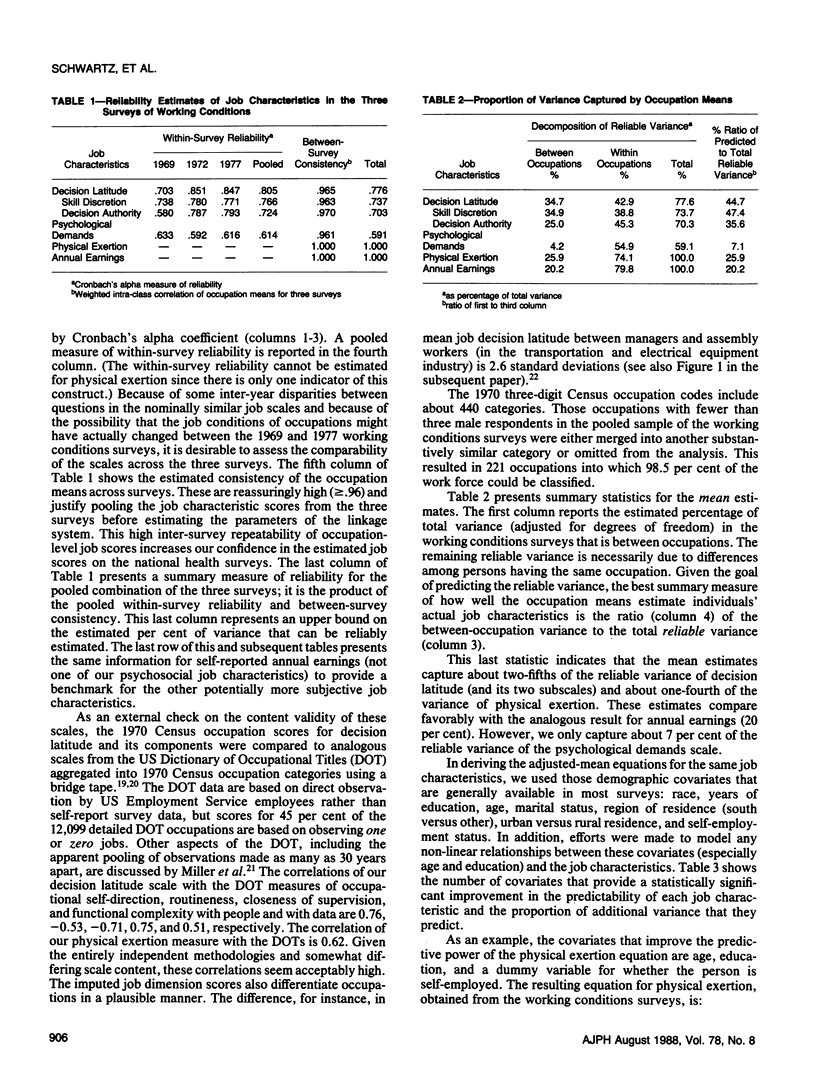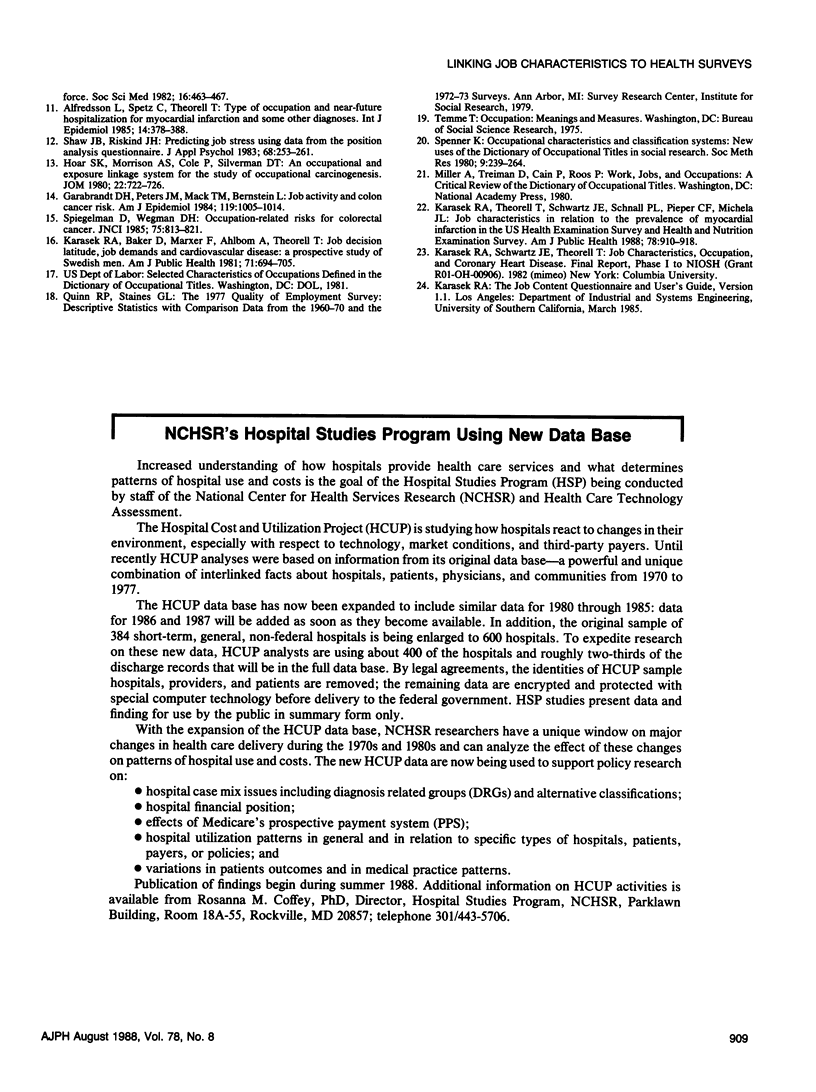Abstract
A system is presented for linking information about psychosocial characteristics of job situations to national health surveys. Job information can be imputed to individuals on surveys that contain three-digit US Census occupation codes. Occupational mean scores on psychosocial job characteristics-control over task situation (decision latitude), psychological work load, physical exertion, and other measures-for the linkage system are derived from US national surveys of working conditions (Quality of Employment Surveys 1969, 1972, and 1977). This paper discusses a new method for reducing the biases in multivariate analyses that are likely to arise when utilizing linkage systems based on mean scores. Such biases are reduced by modifying the linkage system to adjust imputed individual scores for demographic factors such as age, education, race, marital status and, implicitly, sex (since men and women have separate linkage data bases). Statistics on the linkage system's efficiency and reliability are reported. All dimensions have high inter-survey reproducibility. Despite their psychosocial nature, decision latitude and physical exertion can be more efficiently imputed with the linkage system than earnings (a non-psychosocial job characteristic). The linkage system presented here is a useful tool for initial epidemiological studies of the consequences of psychosocial job characteristics and constitutes the methodological basis for the subsequent paper.
Full text
PDF





Selected References
These references are in PubMed. This may not be the complete list of references from this article.
- Alfredsson L., Spetz C. L., Theorell T. Type of occupation and near-future hospitalization for myocardial infarction and some other diagnoses. Int J Epidemiol. 1985 Sep;14(3):378–388. doi: 10.1093/ije/14.3.378. [DOI] [PubMed] [Google Scholar]
- Brenner M. H., Weinerman E. R. An ambulatory service data system. Am J Public Health Nations Health. 1969 Jul;59(7):1154–1168. doi: 10.2105/ajph.59.7.1154. [DOI] [PMC free article] [PubMed] [Google Scholar]
- Catalano R., Dooley C. D. Economic predictors of depressed mood and stressful life events in a metropolitan community. J Health Soc Behav. 1977 Sep;18(3):292–307. [PubMed] [Google Scholar]
- Eyer J. Prosperity as a cause of death. Int J Health Serv. 1977;7(1):125–150. doi: 10.2190/9WA2-RVL3-MT9D-EL9D. [DOI] [PubMed] [Google Scholar]
- Garabrant D. H., Peters J. M., Mack T. M., Bernstein L. Job activity and colon cancer risk. Am J Epidemiol. 1984 Jun;119(6):1005–1014. doi: 10.1093/oxfordjournals.aje.a113805. [DOI] [PubMed] [Google Scholar]
- Harburg E., Erfurt J. C., Hauenstein L. S., Chape C., Schull W. J., Schork M. A. Socio-ecological stress, suppressed hostility, skin color, and Black-White male blood pressure: Detroit. Psychosom Med. 1973 Jul-Aug;35(4):276–296. doi: 10.1097/00006842-197307000-00003. [DOI] [PubMed] [Google Scholar]
- Hoar S. K., Morrison A. S., Cole P., Silverman D. T. An occupation and exposure linkage system for the study of occupational carcinogenesis. J Occup Med. 1980 Nov;22(11):722–726. [PubMed] [Google Scholar]
- James S. A., Kleinbaum D. G. Socioecologic stress and hypertension related mortality rates in North Carolina. Am J Public Health. 1976 Apr;66(4):354–358. doi: 10.2105/ajph.66.4.354. [DOI] [PMC free article] [PubMed] [Google Scholar]
- Karasek R. A., Theorell T., Schwartz J. E., Schnall P. L., Pieper C. F., Michela J. L. Job characteristics in relation to the prevalence of myocardial infarction in the US Health Examination Survey (HES) and the Health and Nutrition Examination Survey (HANES). Am J Public Health. 1988 Aug;78(8):910–918. doi: 10.2105/ajph.78.8.910. [DOI] [PMC free article] [PubMed] [Google Scholar]
- Karasek R., Baker D., Marxer F., Ahlbom A., Theorell T. Job decision latitude, job demands, and cardiovascular disease: a prospective study of Swedish men. Am J Public Health. 1981 Jul;71(7):694–705. doi: 10.2105/ajph.71.7.694. [DOI] [PMC free article] [PubMed] [Google Scholar]
- Kasl S. V., Cobb S. Blood pressure changes in men undergoing job loss: a preliminary report. Psychosom Med. 1970 Jan-Feb;32(1):19–38. doi: 10.1097/00006842-197001000-00002. [DOI] [PubMed] [Google Scholar]
- Morgenstern H. Uses of ecologic analysis in epidemiologic research. Am J Public Health. 1982 Dec;72(12):1336–1344. doi: 10.2105/ajph.72.12.1336. [DOI] [PMC free article] [PubMed] [Google Scholar]
- Shaw J. B., Riskind J. H. Predicting job stress using data from the Position Analysis Questionnaire. J Appl Psychol. 1983 May;68(2):253–261. [PubMed] [Google Scholar]
- Spiegelman D., Wegman D. H. Occupation-related risks for colorectal cancer. J Natl Cancer Inst. 1985 Nov;75(5):813–821. doi: 10.1093/jnci/75.5.813. [DOI] [PubMed] [Google Scholar]


